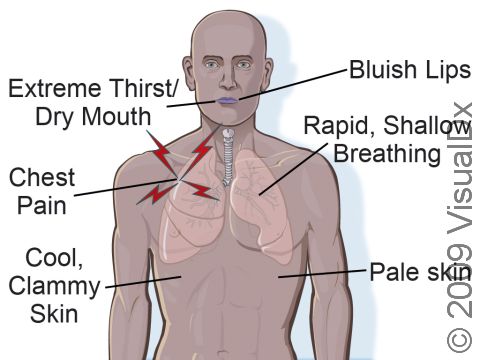Shock, First Aid
Shock is a medical emergency where the flow of blood through the body is reduced, limiting the amount of oxygen the blood carries to the body’s cells. While shock is a life-threatening condition that requires immediate treatment by a medical professional, giving first aid early, while waiting for emergency care to arrive, can help shock from becoming worse.
Shock can accompany any medical emergency, and care should be aimed at treating the underlying injury or illness. Common causes of shock are as follows:
- Anything that causes a reduction in the rate of blood flow (eg, heart failure)
- Anything that causes a reduction in blood volume (eg, dehydration, severe blood loss)
- Extreme heat or cold
- Anything that puts stress on the body
Note: If the shock is due to low blood sugar, see the Unconsciousness text via the Disease List.
First Aid Guide
If there is potential that the person suffered a back or neck injury, simply call emergency medical care and wait. The only reason such a person should be moved is if he/she is in immediate danger in that location. If you are not sure if the person has a neck injury, assume that he/she does.
First aid treatment for shock in an individual without a potential back or neck injury includes the following:
- Contact emergency medical care immediately. Provide any information to medical personnel such as cause of shock, if known, or instructions on a medical alert tag.
- Check the person’s airway, breathing, and circulation.
- If the person bleeds, vomits, or drools from his/her mouth, turn the head to the side to allow fluids to drain.
- Give first aid for the underlying injury or illness. For example, if there is bleeding, apply pressure to the wound, etc.
- Loosen any constricting clothing, belts, or jewelry, and lightly cover the person to keep him/her warm. However, it is important to not allow the person to overheat!
- If there is no possible leg, neck, or back injury associated with the shock, place the person in the shock position:
- Lay the person flat (without any pillows under his/her head), and elevate the feet 8–12 inches.
- If this causes discomfort (eg, pain, difficulty breathing), have the person lay in a way that makes him/her most comfortable.
- If conscious, ask the person pertinent questions. Because he/she may lose consciousness as shock progresses, record the information and give it to ambulance personnel when they arrive. Ask:
- What happened?
- Do you have medical problems?
- Do you take any medications?
- Do you have any allergies to medications?
Note: Do not put anything in the mouth of a potential shock victim. (If requested, you can moisten the person’s lips with water.)
Who's At Risk?
Shock can occur with such medical emergencies as burns, drug overdose, electrical shock, heart attack, severe heat-related illness (heatstroke), low blood sugar, extreme cold (hypothermia), poisoning, spinal injury, overwhelming infection (septic shock), or severe allergic reaction, blood loss, vomiting, or diarrhea.
Signs & Symptoms
Signs and symptoms of shock are any combination of the following:
- Anxiety, restlessness, weakness, and/or dizziness
- Decreased alertness
- A rapid, weak pulse
- Cool, clammy skin
- Rapid, shallow breathing
- Pale skin with bluish lips and fingernails
- Extreme thirst and dry mouth
- Fatigue
- Chest pain
- Nausea and/or vomiting
- Unconsciousness
Treatments
The physician will treat the underlying condition that caused the shock. Treatment can be wide ranging and is specific to what caused the shock and the type of shock that has occurred.
In many cases of shock, infusions of electrolyte solutions (salt water liquid) will be given to replace fluids lost, and measures will be taken to maintain the patient’s body temperature. A blood transfusion may be given if shock is due to blood loss.
Visit Urgency
In all cases of shock or potential shock, seek emergency medical care. Shock is a life-threatening medical emergency that requires prompt professional care.
Last modified on October 6th, 2022 at 2:46 pm

Not sure what to look for?
Try our new Rash and Skin Condition Finder
